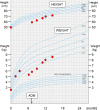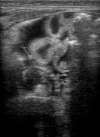Protein-losing enteropathy in an infant with severe atopic dermatitis
- PMID: 33888478
- PMCID: PMC8070855
- DOI: 10.1136/bcr-2020-241057
Protein-losing enteropathy in an infant with severe atopic dermatitis
Abstract
Severe atopic dermatitis (AD) may lead to various complications such as hypoproteinaemia. We describe the case of a 7-month-old male infant with severe AD complicated with protein-losing enteropathy (PLE). He was diagnosed with AD at 2 months of age; however, because of familial steroid phobia, topical corticosteroids were not administered. At 7 months of age, he was admitted to our hospital for decreased feeding, diarrhoea, reduced urine volume and recurrent vomiting. Class 3 topical corticosteroid treatment was initiated. On day 3, eczema had almost resolved. However, serum protein levels had not improved; oliguria persisted and oedema worsened. Serum albumin scintigraphy revealed radioisotopes in the distal duodenum, leading to PLE diagnosis. Systemic prednisolone and albumin were administered, with no PLE relapse after discontinuation. To our knowledge, only two infant PLE cases associated with AD were reported to date. PLE should be considered in patients with severe AD and persistent hypoproteinaemia.
Keywords: dermatology; paediatrics.
© BMJ Publishing Group Limited 2021. No commercial re-use. See rights and permissions. Published by BMJ.
Conflict of interest statement
Competing interests: None declared.
Figures





Similar articles
-
Protein losing enteropathy in severe atopic dermatitis in an exclusively breast-fed infant.Pediatr Dermatol. 2009 Sep-Oct;26(5):638-9. doi: 10.1111/j.1525-1470.2009.01008.x. Pediatr Dermatol. 2009. PMID: 19840339
-
A unique case of collagenous colitis presenting as protein-losing enteropathy successfully treated with prednisolone.World J Gastroenterol. 2008 Oct 21;14(39):6083-6. doi: 10.3748/wjg.14.6083. World J Gastroenterol. 2008. PMID: 18932290 Free PMC article.
-
Factors related to outcomes in lupus-related protein-losing enteropathy.Korean J Intern Med. 2015 Nov;30(6):906-12. doi: 10.3904/kjim.2015.30.6.906. Epub 2015 Oct 30. Korean J Intern Med. 2015. PMID: 26552467 Free PMC article.
-
Systemic lupus erythematosus complicated with protein-losing enteropathy: a case report and review of the published works.J Dermatol. 2012 May;39(5):454-61. doi: 10.1111/j.1346-8138.2011.01404.x. Epub 2011 Oct 31. J Dermatol. 2012. PMID: 22035257 Review.
-
A patient with protein-losing enteropathy associated with systemic lupus erythematosus.Intern Med. 1992 Apr;31(4):521-4. doi: 10.2169/internalmedicine.31.521. Intern Med. 1992. PMID: 1633362 Review.
Cited by
-
Food protein-induced enteropathy: a revision for the clinician.Front Pediatr. 2024 Sep 10;12:1417391. doi: 10.3389/fped.2024.1417391. eCollection 2024. Front Pediatr. 2024. PMID: 39318619 Free PMC article. Review.
-
Case Report: Food Protein-Induced Protein Losing Enteropathy (FPIPLE) in Infancy.Front Nutr. 2022 Jan 31;9:810409. doi: 10.3389/fnut.2022.810409. eCollection 2022. Front Nutr. 2022. PMID: 35174199 Free PMC article.
References
Publication types
MeSH terms
Substances
LinkOut - more resources
Full Text Sources
